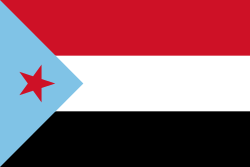
Back اليمن الديمقراطي Arabic اليمن الجنوبى ARZ Yəmən Xalq Demokratik Respublikası Azerbaijani گونئی یمن AZB Паўднёвы Емен Byelorussian Паўднёвы Емэн BE-TARASK Народна демократична република Йемен Bulgarian Republik Demokratel ha Poblel Yemen Breton Južni Jemen BS Iemen del Sud Catalan
People's Republic of Southern Yemen (1967–1970) جمهورية اليمَنَ الجنوبيّة الشعبيّة People's Democratic Republic of Yemen (1970–1990) جمهورية اليمَنَ الدِّيمقراطية الشعبيّة | |||||||||||
|---|---|---|---|---|---|---|---|---|---|---|---|
| 1967–1990 | |||||||||||
| Motto: لنناضل من أجل الدفاع عن الثورة اليمنية، وتنفيذ الخطة الخمسية، وتحقيق الوحدة اليمنية linunadil min ajl aldifa' an althawrah alyamaniah, wa tanfidh alkhutah alkhamsiah, watahqiq alwahdatul yamaniah ("For the struggle to defend the Yemeni revolution, implement the five-year plan, and achieve the Yemeni unification") | |||||||||||
Anthems:
| |||||||||||
| Capital and largest city | Aden 12°48′N 45°02′E / 12.800°N 45.033°E | ||||||||||
| Official languages | Arabic | ||||||||||
| Other languages | |||||||||||
| Religion | Islam (official) | ||||||||||
| Demonym(s) | Yemeni/Yemenite | ||||||||||
| Government |
| ||||||||||
| Secretary-General | |||||||||||
• 1978–1980 | Abdul Fattah Ismail | ||||||||||
• 1980–1986 | Ali Nasir Muhammad | ||||||||||
• 1986–1990 | Ali Salim al-Beidh | ||||||||||
| President | |||||||||||
• 1967–1969 (first) | Qahtan al-Shaabi[a] | ||||||||||
• 1986–1990 (last) | Haidar al-Attas[b] | ||||||||||
| Prime Minister | |||||||||||
• 1969 (first) | Faysal al-Shaabi | ||||||||||
• 1986–1990 (last) | Yasin Said Numan | ||||||||||
| Legislature | Supreme People's Council | ||||||||||
| Historical era | Cold War | ||||||||||
• Independence declared; Arab League membership | 30 November 1967 | ||||||||||
| 14 December 1967 | |||||||||||
| 22 June 1969 | |||||||||||
• Constitution adopted | 31 October 1978 | ||||||||||
| 13 January 1986 | |||||||||||
| 22 May 1990 | |||||||||||
| Area | |||||||||||
• Total | 360,133 km2 (139,048 sq mi) | ||||||||||
| Population | |||||||||||
• 1973 census | |||||||||||
• 1988 census | |||||||||||
| Currency | Yemeni dinar (دينار) (YDD) | ||||||||||
| Time zone | AST | ||||||||||
| Calling code | +969[6] | ||||||||||
| ISO 3166 code | YD | ||||||||||
| Internet TLD | .yd[c] | ||||||||||
| |||||||||||
| Today part of | Yemen | ||||||||||
South Yemen,[d] officially the People's Democratic Republic of Yemen (PDRY),[e] abbreviated to Democratic Yemen,[f][g] was a country in South Arabia that existed in what is now southeast Yemen from 1967 until its unification with the Yemen Arab Republic in 1990. The sole communist state in the Middle East and the Arab world, it comprised the southern and eastern governorates of the present-day Republic of Yemen, including the islands of Perim, Kamaran, and the Socotra Archipelago. It bordered the Yemen Arab Republic to the northwest, Saudi Arabia to the north, Oman to the east, the Arabian Sea to the southeast, and the Gulf of Aden to the south. Its capital and largest city was Aden.
South Yemen's origins can be traced to 1874 with the creation of the British Colony of Aden and the Aden Protectorate, which consisted of two-thirds of present-day Yemen. Prior to 1937, what was to become the Colony of Aden had been governed as a part of British India, originally as the Aden Settlement subordinate to the Bombay Presidency and then as a Chief Commissioner's province. After the collapse of Aden Protectorate, a state of emergency was declared in 1963, when the National Liberation Front (NLF) and the Front for the Liberation of Occupied South Yemen (FLOSY) rebelled against the British rule. The Federation of South Arabia and the Protectorate of South Arabia were overthrown to become the People's Republic of Southern Yemen (PRSY) on 30 November 1967.
On 22 June 1969, the Marxist–Leninist faction of the NLF led by Abdel Fattah Ismail and Salim Rubai Ali, overthrew the Nasserist President Qahtan al-Shaabi in an internal bloodless coup that was later called the Corrective Move. The Marxist–Leninist takeover later led to the creation of the Yemeni Socialist Party (YSP), and South Yemen's transformation into a one-party, socialist state. The official name of the state was changed a year after the reforms to the People's Democratic Republic of Yemen, and was able to establish strong relations with Cuba, East Germany, North Korea, China, and the Soviet Union. Despite its efforts to bring stability into the region, it was involved in a brief civil war in 1986. The PDRY unified with the Yemen Arab Republic, on 22 May 1990, to form the present-day Republic of Yemen.
- ^ Clark 2010, p. 112.
- ^ Lansford, Tom (20 March 2014). Political Handbook of the World 2014. SAGE Publications. p. 1602. ISBN 1483386260. Retrieved 21 July 2025.
- ^ Banks, Arthur S.; Overstreet, William (1983). Political Handbook of the World: 1982-1983: Governments and Intergovernmental Organisation as of January 1st 1983. McGraw-Hill. p. 556-557. Retrieved 29 July 2025.
- ^ [1][2][3]
- ^ a b 1988 Census, p. 22.
- ^ "Country calling codes". 19 August 2020. Archived from the original on 27 May 2024. Retrieved 26 May 2024.
Cite error: There are <ref group=lower-alpha> tags or {{efn}} templates on this page, but the references will not show without a {{reflist|group=lower-alpha}} template or {{notelist}} template (see the help page).



